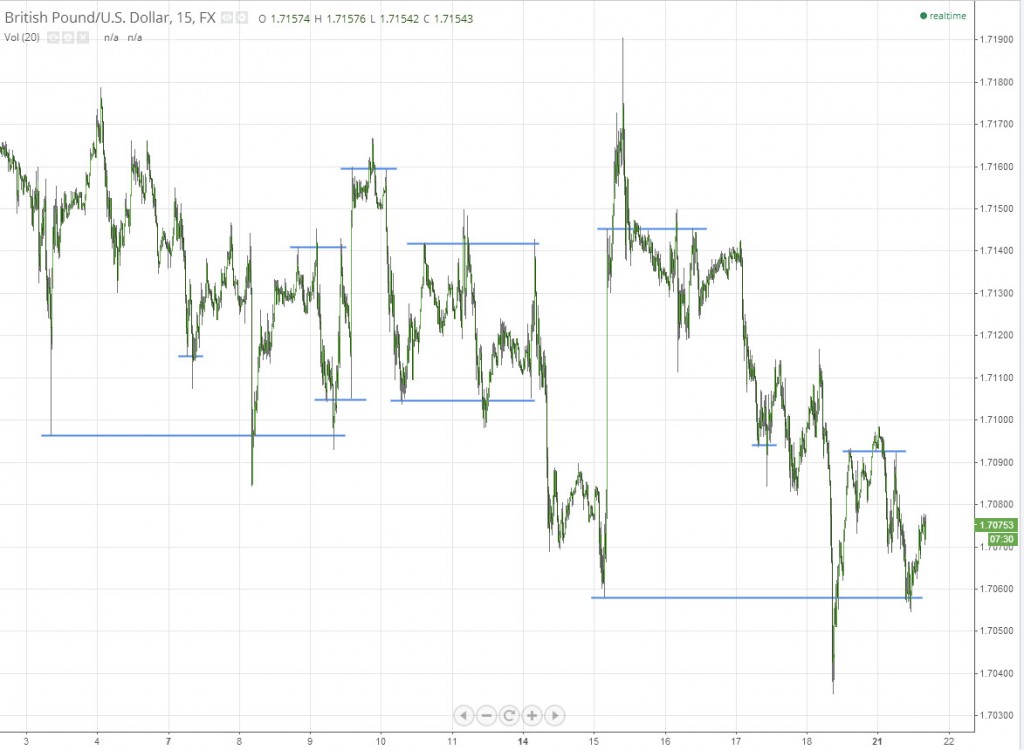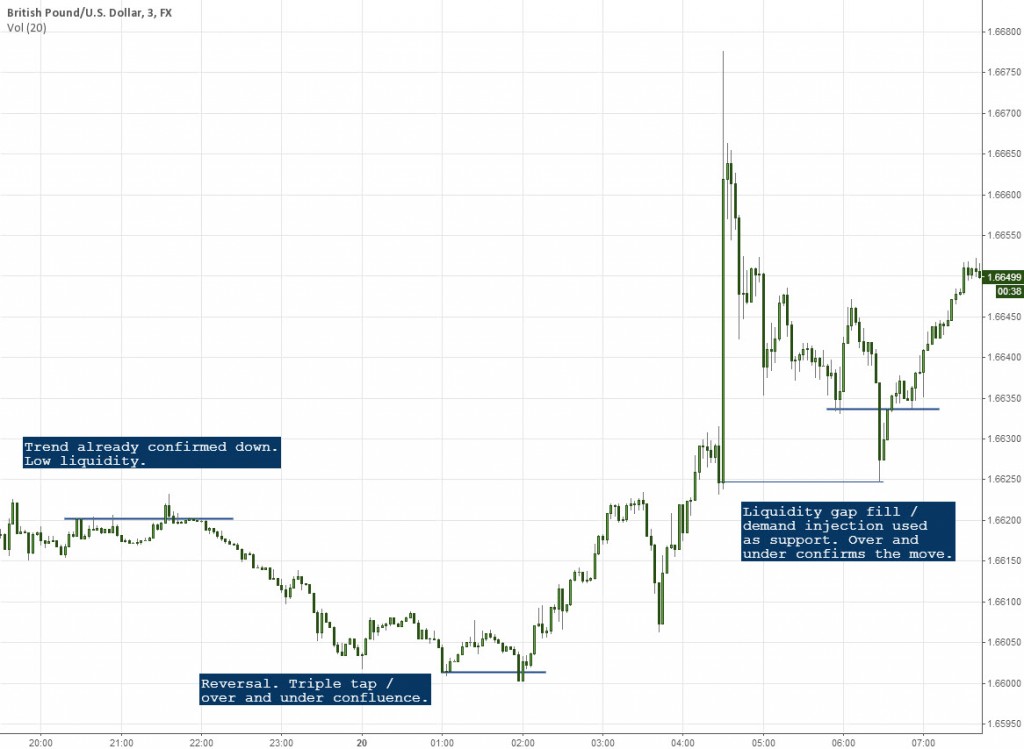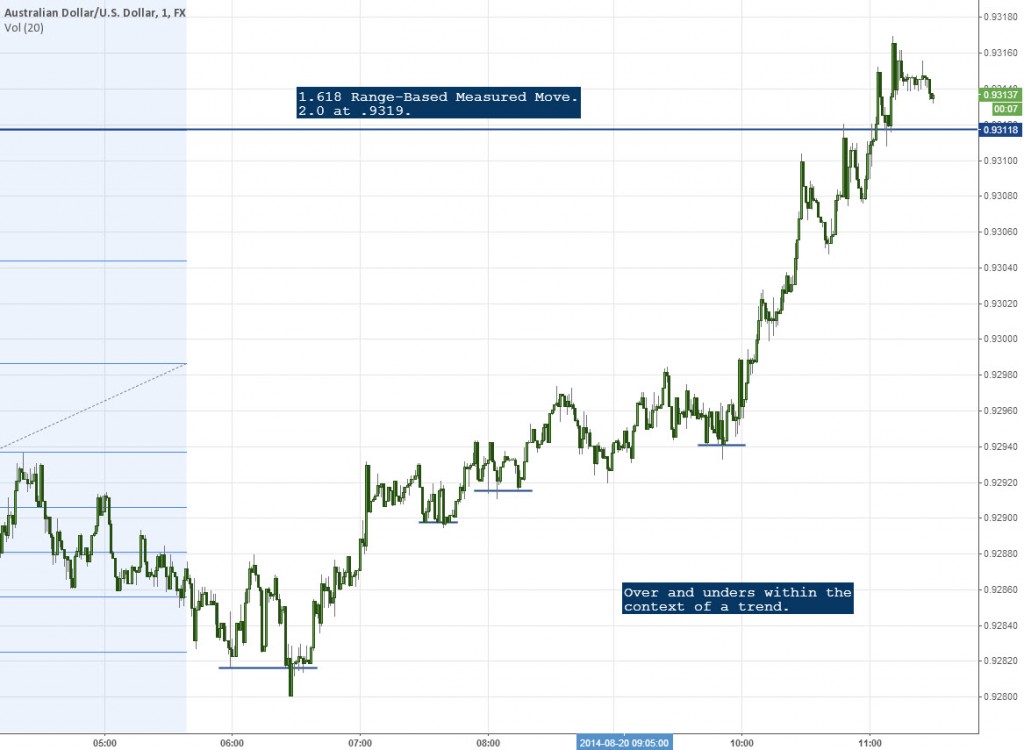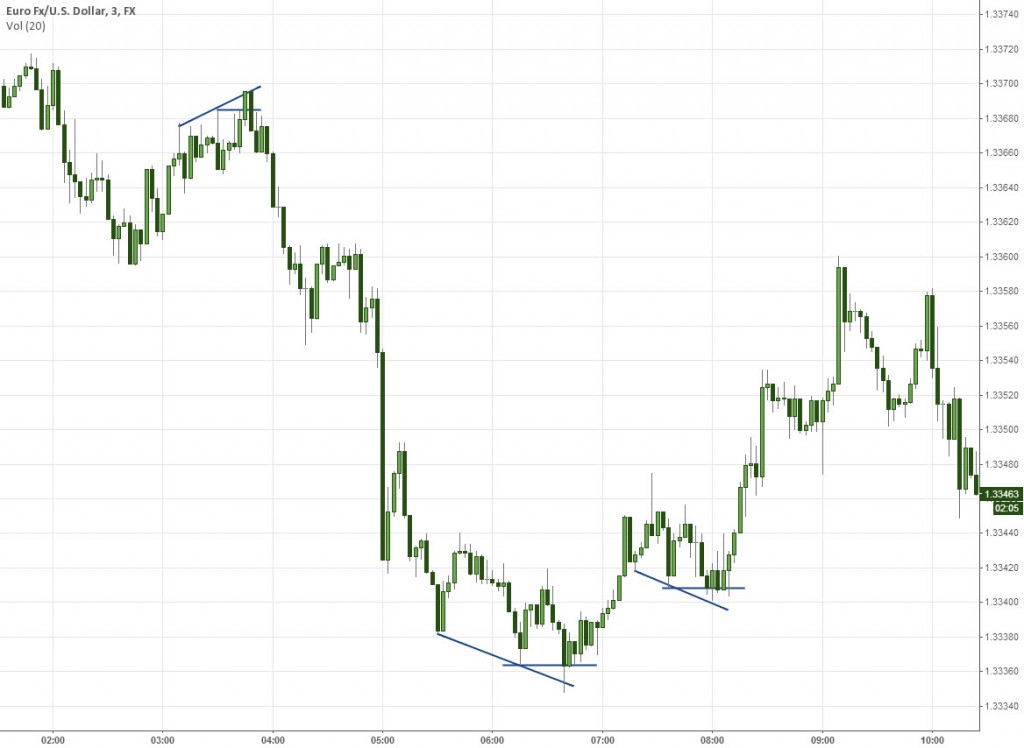I have been treating this blog like a personal log of observations for years, and one of the first patterns I wrote about was the over and under (nicknamed “Quasimodo” by some of our members).
The bulk of my trading consists of a simple set of processes:
1. Fundamental landscape, which for me translates to “how humans (and their machines) react to fundamental data”
2. Stage of a trend. Depending on the timeframe I am trading, I want to see at least 2 movements. I will enter on either the first or second piece of a movement, to a predefined target.
3. Measured move / target. There are countless targets available to traders. What I classify as a “natural” movement in price typically results in approximately 1.5X+ the movement leading immediately preceding it.
4. A handful of entry patterns that happen either at bottoms / major reversals, or in the context of a trend. Over and Unders are one of them.
Why do we like this pattern so much?
Over and Unders follow both conventional and non-conventional price behaviors. Conventional in the sense that they essentially nothing more than the beginning of a head and shoulders pattern. Unconventional in the sense that they follow our rules for inner trendlines and confluence points.
But there is much more to this little pattern than I initially discussed. When I wrote about these many years ago, I had one extra “qualification” that required price to move beyond a specified high or low in order to demonstrate a commitment of buyers or sellers. In many cases, however, you will not find this to be the case. As a result, you will be missing out on a considerable amount of opportunity.
Over time, I have realized the the contextual value of any pattern is of course much more relevant than the pattern itself. After all, there is a reason that most price patterns demonstrate much better behavior when found within the context of trends. Common sense should tell you that your performance should get a bump simply when conditions are prime, by latching onto underlying macro movements.
Context Overrules All
I put particular emphasis on price patterns found within trends for the simple reason stated above. These “rules” stand true in any market. So for today, we will think less about the extra qualification previously stated with this pattern and take a look at the pattern itself with a solid contextual reference.
This same methodology stands true for any other continuation / reversal pattern (more specifics in upcoming posts). As I mentioned earlier, there are really only a handful that I use (6 to be exact). They are:
- Triple Taps
- Over and Unders
- Double Top/Bottom Pullbacks
- Double Top/Bottom Fakeouts (where a double bottom or top is exceeded by a small amount)
- Square roots (Top or Bottom followed by a lower or higher double top or bottom)
- V tops or bottoms
My workday is essentially a constant hunt for these (all the better when there is a combination of them), usually with declining volume, and a simple count of legs and identifying targets. And so for today, we will only worry about Over and Under‘s.
Over and Under's are More Common Than One Might Think
As with any patterns I seek, abundance is a word I like to use in relation to them. If I can't see them everywhere, then I know I am dealing with nothing more than an anomaly. The following chart demonstrates just how common of a pattern these really are. Many of these are of course legitimate head and shoulders patterns as well:
Before you let your mind wander on what each of those levels might represent, I want you to bear one word in mind: yield. Which of these patterns provided the best return, and which ones did you have to “fight against” a little more in order to turn a profit?
The answer is as obvious as you would initially believe it to be, and the shorts as a whole paid off more than the longs (on this timeframe). This is not to say that the longs didn't provide some help as well, but if we are looking at these trades from a safety standpoint then the choice is clear. When found in the context of trends, Over and Unders (and any other pattern) will give up more yield and at a much faster rate than countertrend.
Below is a more recent chart displaying 2 trend following trades, confirmed with Over and Unders, and one reversal:
There are some patterns which are extremely popular: head and shoulders is one of them. Because of this, traders take note when that right shoulder is set in place. These patterns are so popular to the point at which, when a “right shoulder” is seen on a higher timeframe some form of a scalp can very consistently be made with them. A minimum target on these is going to be the neckline itself, with of course a break of the neckline signifying further follow-through in classic head and shoulders form.
In trend following situations, this neckline is going to come very, very quickly of course and so I recommend using measured movements on a more macro scale in order to define your target. As an example:
Here we have a series of Over and Unders found within the context of a trend. Those of you who become “scared” at trading smaller timeframes please bear this in mind: many of these are NOT visible on higher timeframes. We have a clear trendline break to the upside, and you, as a trader, want to get in. In order to find these smaller patterns, you're going to have to scale down.
You can see from the chart that range-based measured move is applied to find a reasonable intraday target. As I write, we are getting 3 shoves to the upside (in a parabolic move), insinuating short-term slowdown. There is also another Over and Under at the peak of price, this very moment (not shown in the chart but explained below).
As far as other patterns on this chart are concerned (used for the purpose of entering this trend) they are there, but I am going to save them for future posts. This pattern in particular is easy to identify and happens very frequently. Witnessing these, in the example above, accompanied with bullish bar behavior thereafter is a prime example of what I personally, actively seek on a regular basis.
Other Pattern Mash-Ups
Over and Unders will commonly appear with other patterns, such as triple taps, as well. In the case of triple taps, the second to last shove is used as the point at which price ricochets. Let's take a look at another example:
Being a 3 minute chart above, once again, more detail can be found. From left to right on this chart, we have a wider channel turning into a sharp drive, and then another small “channel” which is essentially a tripe tap. Within the context of all of this, you have smaller, intraday patterns such as these that can be used to latch onto the underlying movements.
Note that with many of these, the “right shoulder” can be created very soon after the actual lowest low or high. After that, it becomes a matter of breaking trendlines. Bullish or bearish bar closes directly ahead of the opposing trendlines (not shown) will suffice.
The Falsity of “False” Breakouts
One term I have never cared for is “false” breakouts. There is nothing “false” about these. It is normal market behavior: no one is out to “fool” you, no one is out to “get” you, it's just price exceeding a certain level, picking up more order flow, and reversing. Most of the time, it is the result of last minute trend followers latching on for a quick trade, and others reversing at better prices.
When an Over and Under is in place, you may hear the masses calling these a “false” breakout. In my opinion, those using the term “false breakout” are regularly getting fooled themselves. They believe that their support and resistance levels are essentially written in scripture and when they are broken, the “big guys” are running them down (well the second part of this sentence is true). Two little rules rules will keep you out of this mess:
1. Expect it
2. Understand what is normal market behavior
Price running down levels is all a part of a day's routine. Stay on the side of the trend, and you'll be the one running then down.
Using smaller, intraday patterns such as these are going to allow you to latch onto the correct movements. In future posts, I'll cover the others listed above. As usual, my work/life schedule doesn't allow me to update this blog as much as I would like to, but these are some solid beginner points to use as a framework and add to your trading arsenal.








